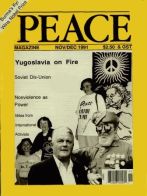
Peace Magazine Nov-Dec 1991, page 28. Some rights reserved.
Search for other articles by Paul Dekar here
THE BROKEN PALMYRA: The Tamil Crisis in Sri Lanka, An Inside Account. By Rajan Hoole, Daya Bomasundaram, K Sritharan and Rajani Thiranagama. Claremont, CA, 1990, 464pp.US $12.00. Reviewed by Paul Dekar
On September 21, 1989 Dr. Rajani Thiranagama, lecturer of anatomy in the University of Jaffna in northern Sri Lanka, was killed as she was cycling home from work. Mother of two and founding member of the University Teachers for Human Rights, Dr. Rajani died in part because of her collaboration in the publication of The Broken Palmyra. Because of this, the book stands as a powerful witness to her courage and the truth she sought to present, as well as to countless other voiceless people whose lives were destroyed to no purpose in the unfinished struggle of the people of Sri Lanka for peace.
At a glance, The Broken Palmyra looks inviting, recalling images of the tourist's Sri Lanka. Majestic palm trees and a spectacular sunset grace the front cover. But Sri Lanka is a ruined land, and the book invites readers to break silence about the destruction of Sri Lanka. As suggested by the subtitle, The Broken Palmyra offers an insiders' account of the Tamil crisis in Sri Lanka. Their story has been suppressed by not only the polar forces which have perpetuated the violence (the Sinhalese-dominated government, the Tamil Tigers and the now-departed Indian occupation forces), but also the international community which has generally ignored the Sri Lankan crisis.
The book is in two parts. The first chronicles the history of the present
crisis. Beginning with disenfranchisement of the Indian Tamils at the time of independence (1948), the authors review the major events which first led some Tamils to begin to organize for the objective of a semi-autonomous state within a federal system, then others to demand an independent state, whether through constitutional means or through violence. The detailed accounts of spiraling violence over the past fifteen years, unabated by the state of emergency declared in 1979, several elections, or the arrival of the so-called Indian Peace Keeping Force in October 1987, serve to expose casual acceptance of evil and disregard for the value of all life.
While all this makes for difficult reading, especially by those not familiar with contemporary Sri Lanka, the second part is even more horrific as the authors disclose numerous reports of heinous crimes. The authors are unrelenting in their criticism of the two forces intended to help the Tamil community, the Indian army and the Tamil Tigers, but their analysis is more complicated. They explore the interaction between politics and economy, the role of the Sri Lankan ruling class to consolidate power, the oppression of women, the continuing legacy of Sri Lanka's colonial past, and the lack of a viable left.
Finally, and only briefly, the authors move beyond despair to offer constructive suggestions for a third way, between passivity and violence, between resignation and fanatic nationalism. They call for a third force who will be characterized not by the words traitor or martyr, but by concern for democracy and moral pressure in de-fence of human rights. They present essential elements or conditions for movement towards peace, including the end of state terror; the end of Indian occupation; the end to killing; bringing the murderers of Dr. Rajani and others to justice; overcoming racial hatred, prejudice and stereotyping; and accepting moral responsibility, caring for the future well being of all, and breaking the silence and indifference and illusions of the present.
While the authors present no blueprint for the Sri Lanka they wish to bring into being, they do point to essential resources for the journey: the forgotten spiritual heritage of the land; nonviolence, in their view the only method of struggle for peace and justice; and universal values including respect for one another's humanity, desire for reconciliation and truth.
The Broken Palmyra will interest not only students of contemporary Sri Lanka, but also the wider community of women and men seeking a more just and peaceful world. The authors suggest a role for outsiders concerned about the crisis in Sri Lanka. They can act to protect those who take risks in standing up for universal values and by encouraging those who work for greater accountability from those who wield power [p.253]. Copies are available from the Sri Lanka Studies Institute, 112 Harvard Ave., Suite 66 Claremont, California 91711 USA.
Paul Dekar teaches at McMaster.

Peace Magazine Nov-Dec 1991, page 28. Some rights reserved.
Search for other articles by Paul Dekar here